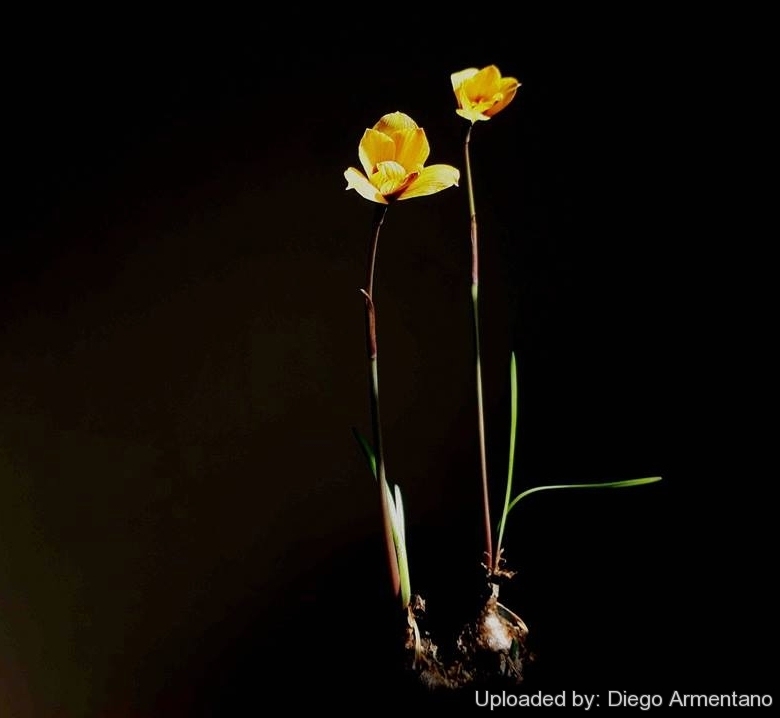
Habranthus tubispathus Photo by: Diego Armentano
Origin and Habitat: Habranthus tubispathusSN|35532]]SN|35532]] is native to southern South America (Brazil, Argentina, Paraguay and Uruguay). It is widely cultivated as an ornamental and reportedly naturalized in the southeastern United States (Texas, Louisiana, Alabama, Georgia, Florida), much of the West Indies as well as Bermuda, eastern Mexico, India, Easter Island, and central Chile.
Altitude range. 0-300 metres above sea level.
Habitat and ecology: Humid and semiarid Pampeana region. In north America Habranthus tubispathusSN|35532]]SN|35532]] is common in grasslands, prairies, and disturbed areas. This species has a high reproductive potential, so the establishment of a single individual could accomplish disjunction.
Synonyms:
See all synonyms of Habranthus tubispathus
back
Accepted name in llifle Database:Habranthus tubispathus (L'Hér.) TraubPl. Life 7: 42 (1951).Synonymy: 31
back
Common Names include:
ENGLISH: Copper lily, Rio Grande copperlily, Barbados snowdrop, Crocus lily, Copper-lily
Description: Habranthus tubispathusSN|35532]]SN|35532]] is a small, erect, bulbous perennial 10 to 20(-30) centimetres tall when in flower. Flowers are produced sporadically during late summer and autumn, singly on stems before the narrow, dark green leaves. The flowers are solitary, funnel-shaped, 2.5cm wide usually yellow with copper tones and appears in summer and autumn. The leaves are linear or narrowly strap-shaped. This bulb has a high aesthetic ornamental value for sustainable landscaping. The synonym Habranthus andersoniiSN|35532]]SN|35538]] is often found in horticultural sources.
Derivation of specific name: Habranthus tubispathusSN|35538]]SN|35532]] derives its specific name from its tuberous spathe.
Leaves. Few, basal, narrowly linear to lanceolate, typically shorter than scape not normally present at flowering time, appearing later. Leaf blade dull green, to 4 mm wide.
Flowers: Solitary, at end of a slender scape with a spathe to 2-3 cm long. Pedicel (2–)3.3–4.5(–5.6) mm long, exceeding the spathe. Perianth 2.1–3.1 cm long, usually yellow with copper tones on the outside or orange-red with a reddish brown centre and veins, funnel-shaped, with 3 sepals and 3 petals similar in shape and colour, somewhat spreading, not reflexed. The petals are fused for a short distance at the base to form a tube, about 2 mm long and tinged green. The flowers are not upright on the stem but held at a slight angle. Filaments 0.8–1.8 cm long. Anthers (2–)4–5 mm long. Style 1.8–2 cm long; stigma trifid, linear, equaling or rarely extending more than 1 mm beyond anthers. A form with pinkish flowers is grown as Habranthus tubispathusSN|35532]]SN|35532]] var. roseus, but may be a hybrid.
Chromosome number. 2n = 24.
Bibliography: Major references and further lectures
1) Wikipedia contributors. "Habranthus tubispathus." Wikipedia, The Free Encyclopedia. Wikipedia, The Free Encyclopedia, 10 Oct. 2018. Web. 16 Dec. 2018.
2) Wikipedia contributors. "Bract." Wikipedia, The Free Encyclopedia. Wikipedia, The Free Encyclopedia, 30 Oct. 2018. Web. 16 Dec. 2018.
3) Michael Eason, “Wildflowers of Texas”, Timber Press, 3 April 2018
4) “Flora of North America: Magnoliophyta: Liliidae: Liliales and orchidales”, FNA Vol. 26, Oxford University Press, 1993
5) (PDF) "Reproductive biology of Habranthus tubispathus". Available from: https://www.researchgate.net/publication/270588332_Reproductive_biology_of_Habranthus_tubispathus [accessed Dec 16 2018].
6) Mathew, Brian, “The Smaller Bulbs”, London: B.T. Batsford, 1987
7) RHS Plant Selector - "Habranthus tubispathus". Retrieved 16 December 2018.web:http://apps.rhs.org.uk/plantselector/plant?plantid=4484
Cultivation and Propagation: Habranthus tubispathusSN|35532]]SN|35532]] tolerates some frost down to 0 °C if planted in a sheltered sunny position, but will not survive being frozen. It seeds freely.









